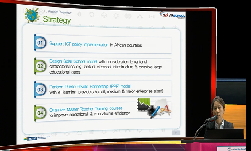Learning with technology is a challenge for both designers of and students in online degree programs. Due to new accreditation standards, pharmacists are returning to school. Pharmacy professionals, looking to update their skills, understandings and ...
http://chineseinput.net/에서 pinyin(병음)방식으로 중국어를 변환할 수 있습니다.
변환된 중국어를 복사하여 사용하시면 됩니다.
- 中文 을 입력하시려면 zhongwen을 입력하시고 space를누르시면됩니다.
- 北京 을 입력하시려면 beijing을 입력하시고 space를 누르시면 됩니다.
Visualizing understandings online: Nontraditional pharmacy students' experiences with concept mapping.
한글로보기https://www.riss.kr/link?id=T10594065
- 저자
-
발행사항
[S.l.]: The Ohio State University 2003
-
학위수여대학
The Ohio State University
-
수여연도
2003
-
작성언어
영어
- 주제어
-
학위
Ph.D.
-
페이지수
350 p.
-
지도교수/심사위원
Adviser: Thomas McCain.
-
0
상세조회 -
0
다운로드
부가정보
다국어 초록 (Multilingual Abstract)
Learning with technology is a challenge for both designers of and students in online degree programs. Due to new accreditation standards, pharmacists are returning to school. Pharmacy professionals, looking to update their skills, understandings and degree, find themselves overwhelmed with new information and are often without the capacity to incorporate it effectively into their practice. The implications for postsecondary education are profound. Information overload is the operative mode in which students and teachers now exist. Learning in this information rich environment requires different tools and pedagogical methods than are currently used in online learning environments. This dissertation is a report of how pharmacists can learn and communicate in new ways to become better practitioners and better learners.
The practical work of developing and testing usable knowledge about online learning environments requires a fundamental understanding of the learning and technology experiences students bring with them to their learning environment, conceptual change processes, information visualization tools to help students visualize what they know, and collaborative learning pedagogies to facilitate sharing of students' understandings.
This study explores the role of concept mapping as a tool to help students visualize what they know and to communicate their understandings with other students in an online learning community. While the pharmacists did concept map their understandings and acknowledged the benefits of working together, they did not share their concept maps. This study proposes a collaborative online learning community model for nontraditional students to explain these results. The model suggests the following. First, becoming an expert with a new tool takes time, hands on experience and may be a prerequisite to using the tool to learn and communicate in a learning community. Second, for students to move past public presentation of their ideas and into collaborative peer review of others' understandings, teachers must understand the decision making risk analysis nontraditional students employ. Third, building functional learning communities is difficult and takes time.
Further research is needed to determine if these changes in how concept mapping is implemented and prioritized affect nontraditional students' sharing of understandings in online learning environments. GIF, QuickTime and WAV files are included.
분석정보
연관 공개강의(KOCW)
-

Education Policy at the Party Conferences
Teachers TV Teachers TV -

Further Education: Work Experience
Teachers TV Teachers TV -

Alcohol Education: Here's What We Want
Teachers TV Teachers TV -

2014 이러닝 국제 콘퍼런스 : What is the Lessons from Education Support Project~
한국교육정보진흥협회 Boseon, Kim -

Personal Finance Education: The Money Quiz
Teachers TV Teachers TV






